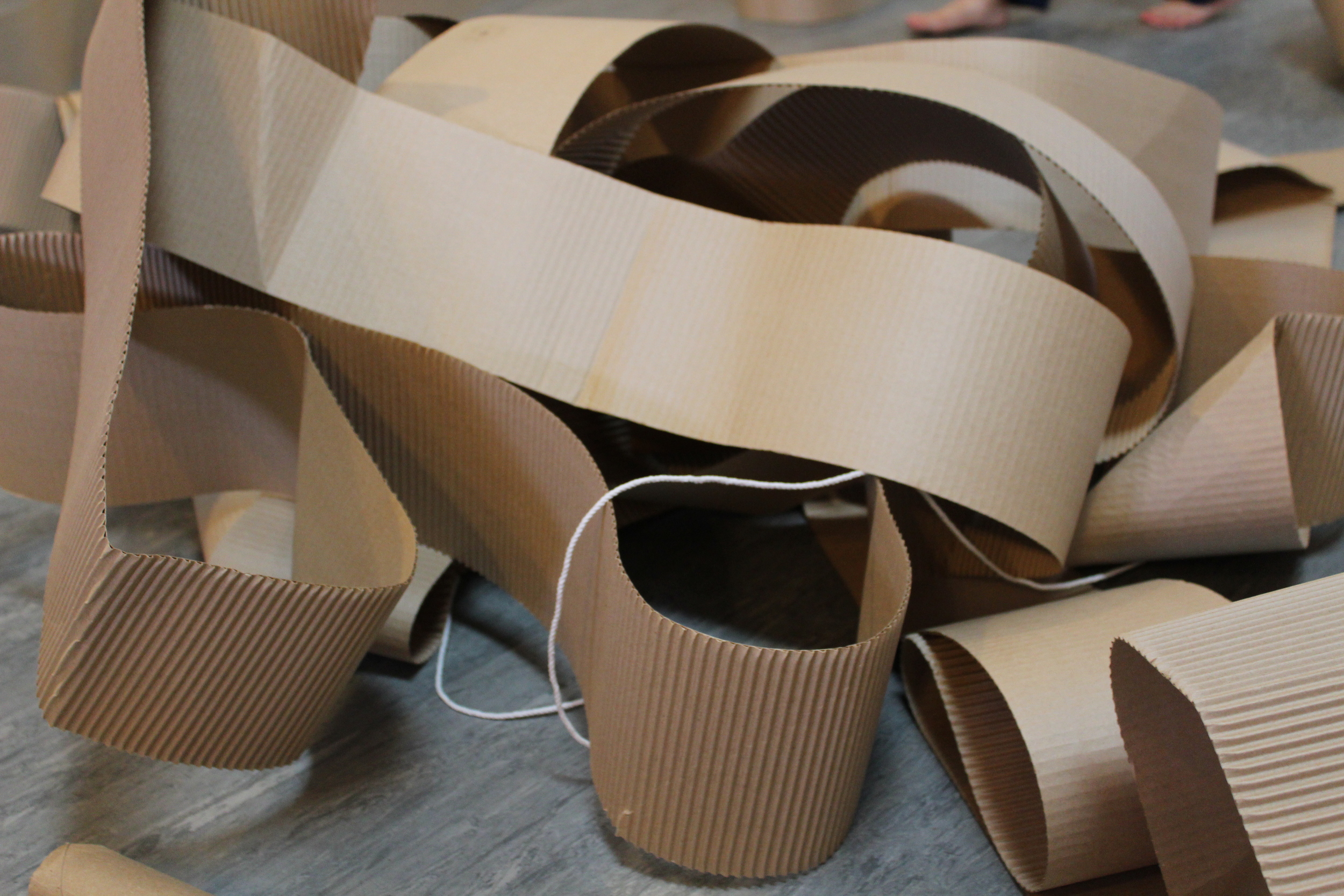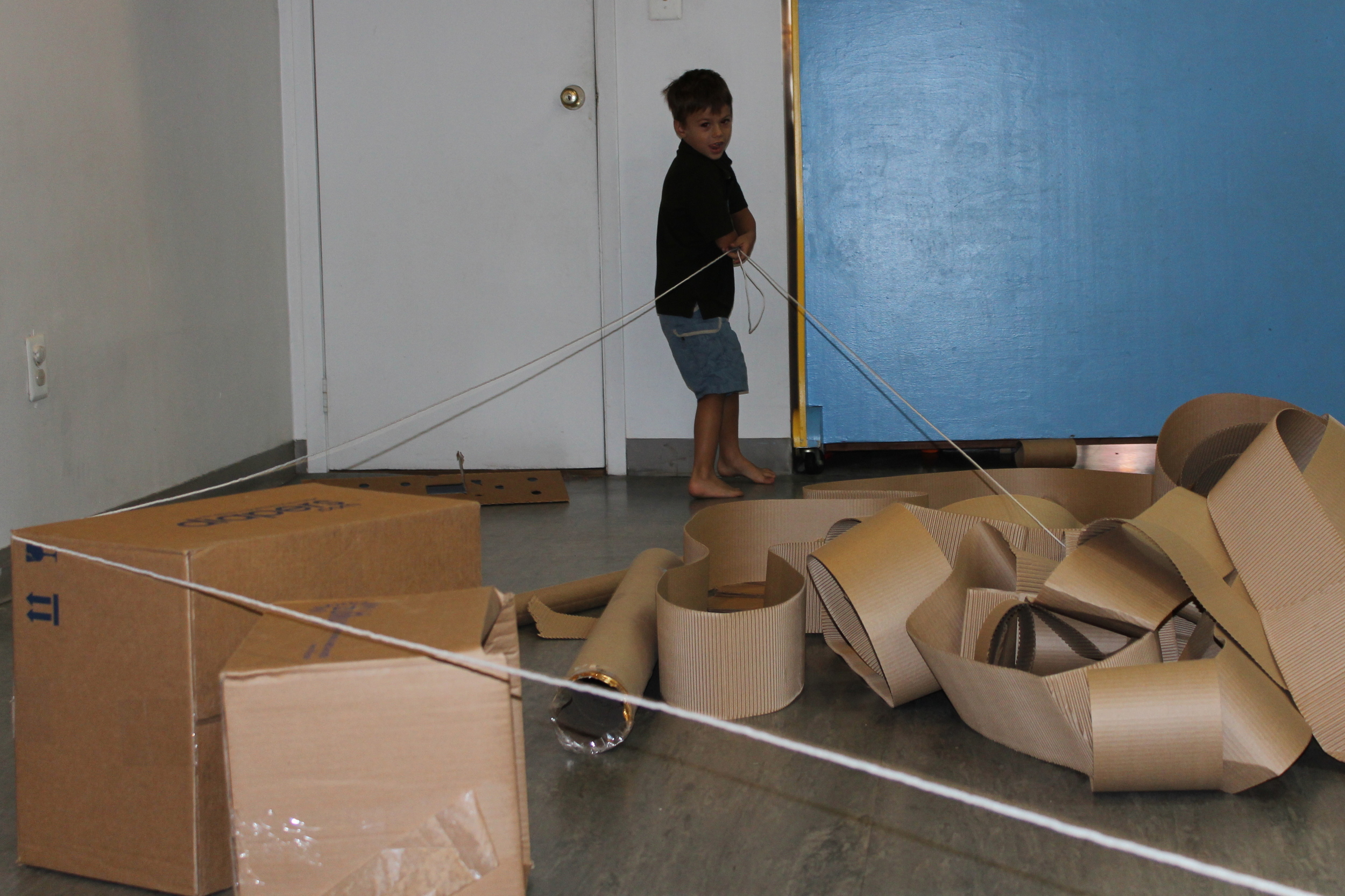Cardboard!
Why CARDBOARD?
Materials in space rest and curve.
Well, first of all, what child doesn’t eventually prefer to climb into the box surrounding the shiny new toy it just delivered? Cardboard is lightweight, child friendly, recyclable, comes in great variety, and can easily be used to create paper sculpture. You can cut it, glue it, stack it, crush it, paint it and even wear it! Isn’t cardboard really every art teacher’s dream? Children will be coming into contact with this material their whole lives. So let’s use it!! Over the years we have been collecting pieces of cardboard in a variety of sizes, shapes, and interesting textures. Our collection includes odd-shaped packing forms, paper towel tubes, huge carpet dowels, small and large boxes, egg cartons and a very long roll of corrugated paper. We purposely select pieces in non-dyed colors to preserve the natural feel and to draw attention to form and texture. These treasured items have been stored away and awaiting children’s curious explorations. We know the children will appreciate the possibilities as much as we do!
Find & Seek #2 at ArtsCetera
High, low, up and down: Cardboard World!
On August 28th, 2012, a small group of children (9 to be exact), ages 18 months to eight-years, collaborated in a room filled with these amorphous and strange cardboard forms (along with a little string and some gold duct tape). The first day with a new material, as with any art-making material, whether it be paint, clay, wire, musical instruments, or whatever else we can conjure, we feel it is best to allow as much free time as possible to explore and examine, to share and inquire. So without much provocation, children were invited to just play…
What themes and imaginings occurred? In the short hour and a half that we spent together, and for some it was less, cardboard was put to use in a myriad of ways. It became pirate costumes, telescope-like instruments to gaze through, places to sit, hide and relax, little places with doors, windows, and ceilings, nests for treasures, bowls for nesting objects and serving pretend food, logs to balance upon, various components of a range of different buildings, and it was even used to engineer a tiny working elevator! The experience required sharing a large space and for some, materials negotiations with peers. It was discovered that pieces could not only be combined in a variety of ways, but that they could also be propelled, either by throwing or dragging. The younger children were not so different from the older ones in their willingness to create, however, the older children naturally were able to adapt the string and tape as it was more suited to their developmental abilities. What did these children not do? Nobody shredded a cardboard tube or smashed a carton to bits, although that would not be surprising as we’ve seen it done before! The children seemed happy to use the materials primarily as they were in their natural forms.
The Intricacies of our Observations
A box space awaits. It doesn’t take long for a child to discover the possibilities here. Many children discover the joy of climbing into boxes. A box makes a brilliant hideaway space, a place to remain hidden for a while. A box big enough to sit inside will most definitely become a seat. Some pieces inspire pretend kitchen play. Corks and an egg container work to play kitchen. Lunch is served! The corks represent each a tasty morsel of something good to eat, carefully placed where they nestle perfectly in the cups.“Look what I can do!” An eight-year-old girl beckons to us, just before meditatively balancing on a cardboard tube.
An abandoned roll of cardboard resting upon a tube is such a beautiful form full of interesting shapes and shadows. We couldn't help but document through the camera lens. What do the children see here?
Looking through the telescope.
Observing a pile of cardboard, a sculpture in two dimension.
Taking a mass for a walk.
Here Ye! Is that a knight in shining armor?
Inside, Underneath and Above
A boy appears looking through a telescope, peering through the rounded openings of cylinders. Attaching them together has further purpose. The openings provide different views and serve different functions. The boy tries looking through and upward, checking out the view from a variety of angles. Will looking through to the ground while peering through the tiny opening reveal a new perspective or a hidden secret?
We photograph a kind of Artscape of Materials. We think of materials as seen through the eyes of a camera lens. Were a picture of this kind to be presented to our child participants, what might they see there?
Materials are amassed, rolled out, spread out, spilling over into the space. The room continually transforms. Getting up close provides an interesting perspective of this transient world.
Moving the mass is a delightful discovery! A five-year-old boy can engineer a way to take the mass of cardboard forms for a walk. The forms appear to move as a single unit as the rope clings on to pieces in a triangular configuration.
Some cardboard is wearable! Suiting up, two boys figure out that this garble of rolled paper is actually wearable. This is exciting and inspires one to spin and laugh freely. Cardboard feels and looks a bit like armor. The boys continue suiting up for battle, perhaps as a king, a knight or a pirate. Dressing up is a common expression of young children as it leads them further on a journey through make-believe adventure.
What is happening for us as facilitators
As we engage with children in these open-ended play workshops, most importantly we are beginning to find that interesting themes emerge and that stories develop. We try our best to listen and watch closely to what children do and say. We record and ask questions. Every interaction becomes a valuable new piece of information, bringing us closer to understanding the imaginary worlds of young children.
What does this all mean for children, all this unstructured manipulation of stuff? Where can it lead? Many places! We hope a conversation may develop around a story or play. Perhaps children will be compelled to build a city or world as a collective group. Perhaps children will consider the addition of other materials as we slowly present them, such as chalk, paint, glue, buttons, fabric. The direction it goes depends on the children and what they are trying to say. We look forward to deepening the process with future groups! We thank all the young participants and their willing caregivers for expressing interest in imaginative play. And thanks again to Howard Weiss and the staff at ArtsCetera for hosting us!
Box panel hideout.







